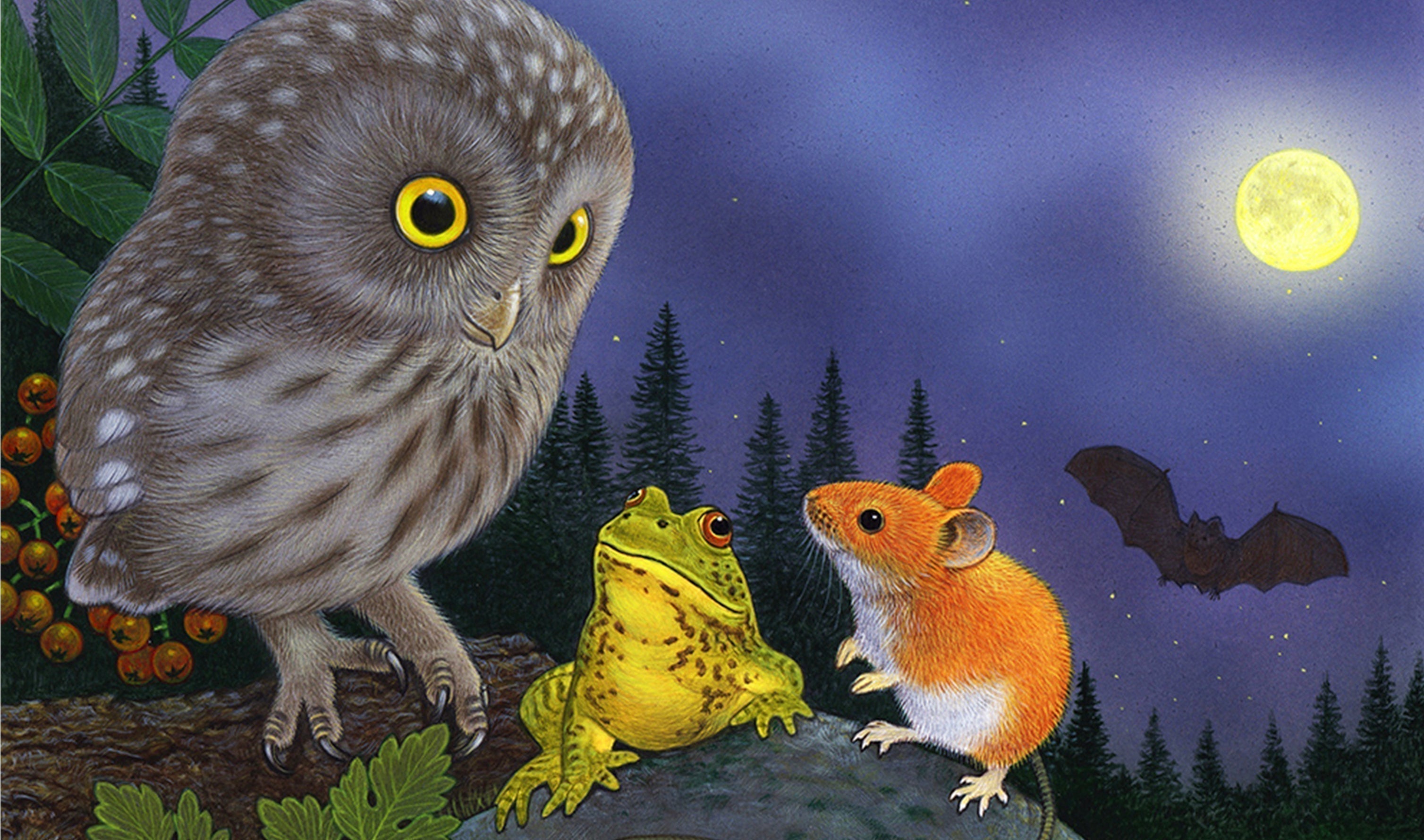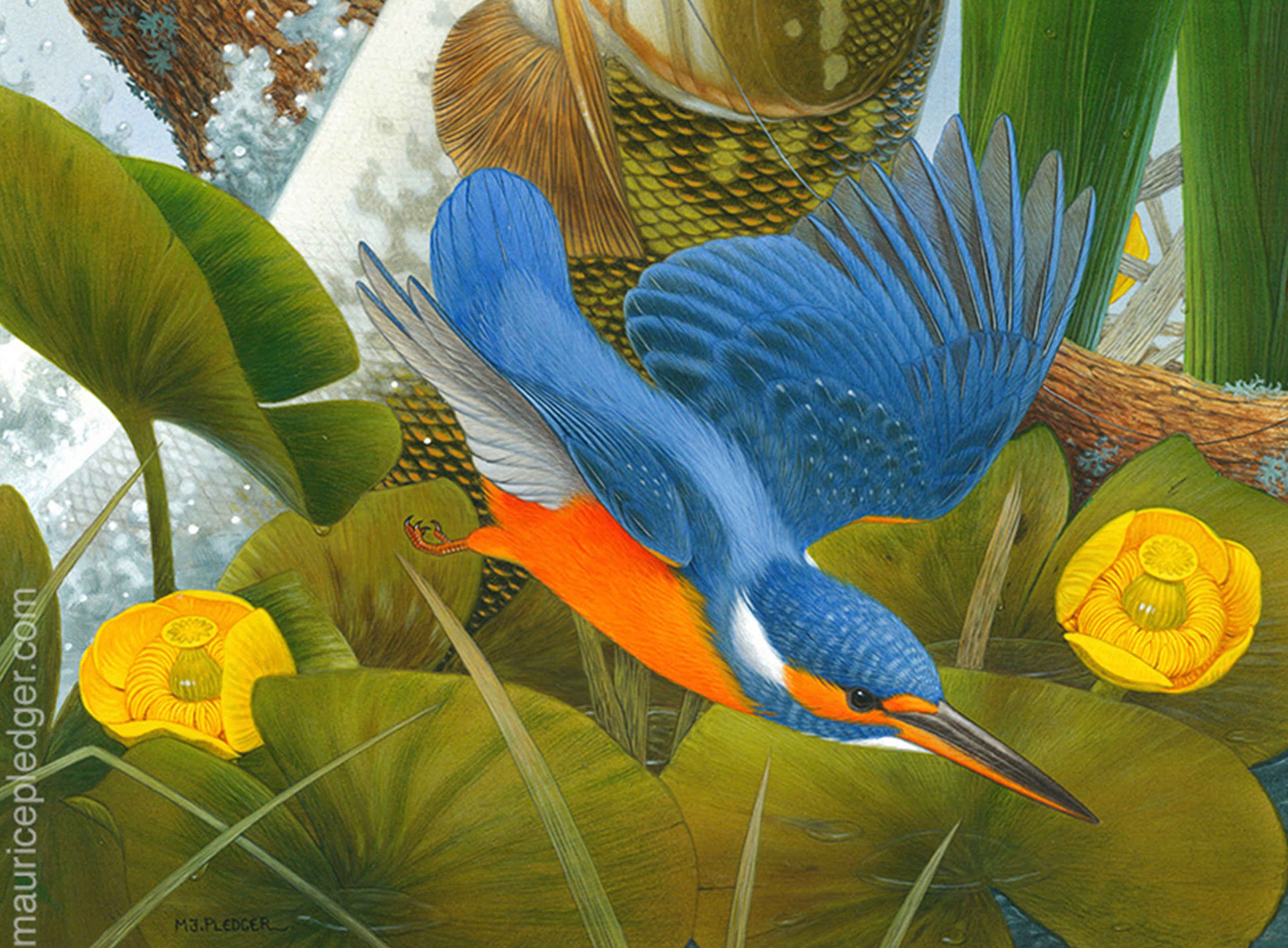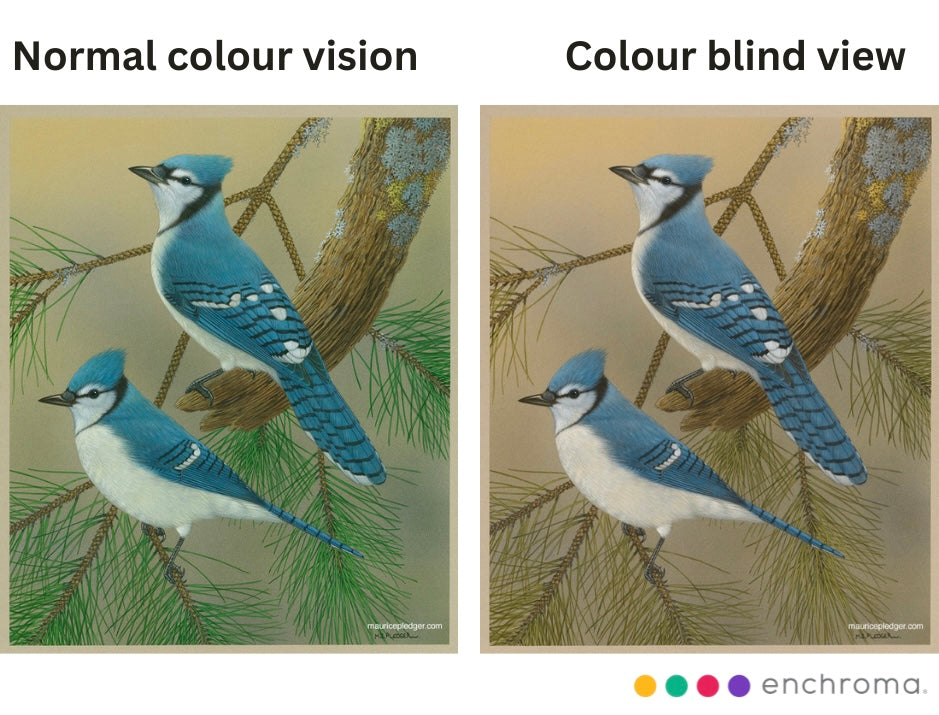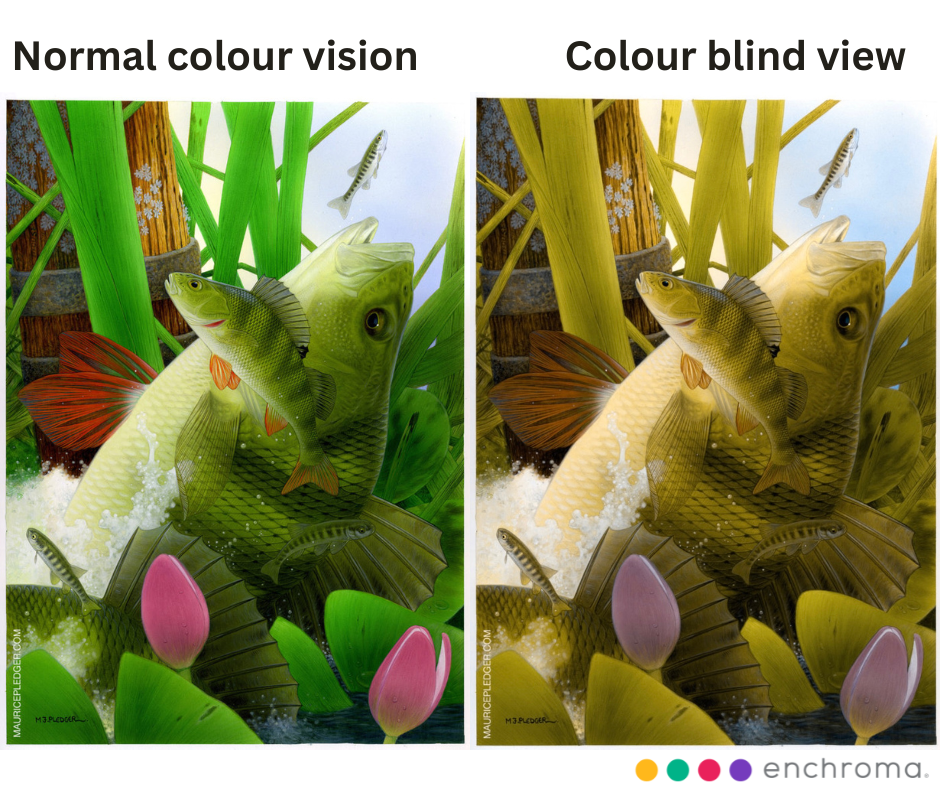
Maurice Pledger
Even now after all these years, when I have various different colours all over the place on my mixing tray, most of the time I can’t see the difference.
About the Artist
I’m looking at a weird picture in a small book of a vague image of a lady with a hat on, holding some baskets with flowers in and a kind of windmill in the background. My best friend Vince is next to me wondering what the hell I’m on about, and was tracing out a big number with his finger on the same picture. I obviously couldn’t see it and thought he was madder than he thought I was. It was a circular image made up of hundreds of different colour dots, and it was being handed around the class where it ended up on our desks. The school doctor had paid our class a visit. It was 1966 and we were eleven. On the back it said that anyone with normal colour vision would see a large number, of which I was blissfully unaware of, while anyone who, in layman’s terms, was red-green colour blind, was gifted with a lady from Holland holding two baskets of tulips. And so with this, this was the moment I became aware of the fact that I was red-green colour blind. Quite badly as it turned out. Not that it bothered me in the slightest, we all thought it was pretty funny to be honest. Little did I know at the time, but looking back now over the years, I could see a meandering path which lay before me dotted with a few pot holes. I dodged most of them and fell in a few but there you go.
I was born in 1955. Anyone wishing to delve into my past or past history, I dare say you’ll find snippets regarding my colour blindness written up in all manner of articles and books, in particular my three autobiographical fishing books; While My Float’s Still Cocked, Water Colours and Still Half-Cocked. Back to 1966 and the classroom. Returning home, I happily mentioned to my dear mum and dad, Leda and Doug Pledger, of my news with the lady from Holland. Mum smiled I suppose and dad half- smiled in a dismissive kind of way. Dad was, by profession, funnily and luckily enough (for me anyway), a Lithographical Colour Printer, and as such, his whole life revolved around colour and its association with printing. Dad’s hobby was photography, and he spent every waking moment taking photos and developing them in the kitchen which he blacked out in the evenings. Initially it was black and white, but eventually he drifted into colour printing and I watched in awe as he juggled colour balances to achieve what he wanted. I spent no end of time with him developing his photos. Because of their love of nature and all wildlife, especially birds, and the fact we’d always lived in Hoddesdon, Herts, we were always going for long walks in the countryside and taking thousand and thousands of photos. Something I still do. Thanks to this and their love and encouragement, I’d already begun to draw birds a few years earlier. This love of drawing was born from my lovely Uncle Sergio who lived in Bologna Northern Italy. Uncle Sergio was an extremely talented oil painter, and from the moment I was born, every moment we spent on holidays visiting my mum’s side of the family, it would be in his company and watching him paint. Quite simply, I just wanted to be like him. So began an insatiable desire to emulate the great bird artists Basil Ede, Archibald Thorburn and Arthur Singer, from the wonderful bird books they’d bought me. In particular, Basil Ede. So much so that I wrote a letter to Basil, including six of my little pencil drawings, and on the 1st of December 1966 he wrote back to me, a wonderful letter with a few pencil sketches to illustrate a few points. His letter appears in my fishing book Water Colours which I’ve already mentioned. Mum and dad clearly saw the love I had for bird illustration, and with this wonderful encouragement from one of the world’s greatest bird artists, the world of wildlife illustration lay before me. Waiting. Following mum’s suggestion of actually colouring in my pencil drawings, I’d already been using a set of Poster Paints for a little while at that point. In his letter, Basil suggested I used what he did, Sable brushes and Winsor and Newton Artist’s Watercolours and Gouache. Very expensive but mum and dad spared nothing to give me the best. Dad could get me no end of paper and card from work, and Oram and Robinson Artist Suppliers was only a short ten minute drive up the road. I’m finding it very difficult to try and condense a lifetime to a few sheets of paper, but if you’re still here, thanks for your patience; the pot holes are coming into view. I slowly became familiar with Winsor and Newton’s gouache and watercolours and my selection grew and grew; not that I could see half of them, but by checking the names on the labels, at least it gave me a start. Over the next few short years it became obvious to even dad, that my use of colours was at best, wanting. It wasn’t long before dad began helping me, and every time we mixed a new colour, under his supervision, we made up a few sheets, swatches of colour, with the names of the tubes we’d use in the mix. So, for example, the brown of a Robin was made up with raw umber and a touch of olive green. The breast was light orange lake and scarlet lake. Modelling and feather detail was me guessing my way along, with streaking in amounts of naples yellow and burnt umber on the head and wings, and spectrum yellow on the breast. In effect, it was me stumbling along, using colours which to my eyes, were lighter or darker than the main colour wash. I knew I was getting things right a few times at least, when dad’s criticisms became less and less. Now and then we hit a block, typically on the grey of a Jay, when dad’s insistence that his colour mix was perfect, and me with my interpretation as being totally wrong. Of course I always bowed to his better judgement, often finishing a painting wondering what the hell I’d done. Somewhere along the line it kind of went off the rails a bit. I was commissioned to paint a large Barn Owl, maybe 16” x 14” or so. I decided to paint it on grey Canson art paper where the white of the owl would really stand out. Especially with it sitting on a broad section of dark tree trunk. Things were going fine until I realised that the one remaining tube of burnt umber I’d been using for the tree was now flat. I headed off to Meadows in Hoddesdon who had a fine art section upstairs. I ran in, grabbed the three remaining tubes of burnt umber and returned home. Adding at least a quarter of a small tube to the dwindling amount in the mixing tray, I happily carried on until dad came home, finishing it just as he walked in. “How’s the owl going?” “Great, just finished…have a look.” The only time he ever got cross at me in his life, “What the hell have you done?” “Er, finished it.” Apparently, for some reason, the wrong labels were attached, and instead of the desired burnt umber, I’d now painted the whole tree in alizarin crimson. Which just happened to be most of the painting. No end of dabbing out or overpainting ever got rid of it. Not that I could see what I was doing anyway. Even now after all these years, when I have various different colours all over the place on my mixing tray, most of the time I can’t see the difference. Olive and hookers green, raw and burnt umber, raw and burnt sienna, yellow, gold and brown ochre…..if I walk away not paying much attention and come back to any permutation of any of these, I quite simply don’t know which is which. No end of times when my children Douglas and Laura were at home, even when they were two or three years old, I’d ask them, “is that green or brown?”, and then I’d know and carry on. I remember one day years ago, not paying too much attention, after having answered a phone call, I returned to finish off a Robin’s breast with the colour of its head and back. Sometimes I have to resort to writing BU next to burnt umber, OG next to olive green and so on. A few years along the line when I was just over seventeen, I joined the London artist’s agency, Linden Artists Ltd., headed by Bernard Daniels and Dennis Bosdet. Bernard Thornton who joined at the same time, concentrated his interests on the agency side of things and his career progressed to being the shining light in the company, finally leaving to set up his own one man agency, Bernard Thornton Artists. Probably the most highly regarded artist’s agent in the country, if not the world. Our friendship, both personal and business, continues to this day. Going back, when I joined Linden Artists, I was told it probably wasn’t a good idea to tell prospective clients that I was colour blind. Not that it bothered me, I always treated it all with a smile, but on occasions it really did matter. Being commissioned to paint a series of warblers for a birdwatching guide presented me with no end of problems. Any particular variations of plumage, mostly very subtle, had to be shown in each image, and if one warbler was slightly ‘more olive’ in colour or its legs had an ‘ocherous tinge’, I really was at a loss. I would add maybe a slight wash of olive green where i thought it might be needed, but often had the artwork returned to correct it yet again. I muddled through but that was the last time I accepted work of this kind. Years later when my work drifted towards children’s books, another pot hole came into view, but one which I neatly side-stepped with a few adjustments. I really have lost count of how many children’s books I’ve illustrated, probably over fifty. Many of these featured various characters, for example, Billy Bunny, Charlie Chick, Morris Mouse etc, and as such, each one had to shown many times as the stories progressed. Because of this, I had to be very careful with repeating the colours as faithfully as I could from the previous pages. A new book was started with colour swatches and samples, along the same lines dad and I had made before. Billy Bunny: permanent white, touch of neutral tint, tiny bit of raw umber and so on. That way, referring to each character, I was more or less able to manage things. And then one day another pot hole came along and although I well and truly fell in, I somehow managed to crawl out. Most of my children’s books were commissioned by Mandy Wood, head of Templar Publishing, and together we produced title after title, series after series, with one in particular, featuring a new character, Lexi Lion. Previous books in this series of Ping Ping Panda and Tavi Tiger presented no problems whatsoever, but the request came through from Mandy, “Can you paint a lion cub?” Having just finished the tiger cub, I could see no problem at all. Until I began to paint it. The cover was needed first of all and I finished the drawing which was okayed. Dad had sadly died and as I had never painted a lion, I felt as if I were on my own. The overall base colour seemed to me to be a washed out biscuit colour. Right or wrong, everyone I asked seemed to be okay with that. The detail of the hair and darker streaks again, proved to be easy enough. I guessed at all the other colours necessary to darken things, but when it came to start overpainting with lighter and lighter hairs, that’s when the problems set in. As I started building up layers and layers of yellow ochre and naples yellow streaking, I made the mistake of trying to finish highlights off with even brighter streaks. For these I chose, wrongly it seems, lemon yellow, on its own and mixed with white. For some reason, and now as I write, I still have no real idea what went on. The lemon yellow, when painted over what I’d already laid down, turned to, or showed up as green. Great patches of it, none of which I could see. So when I showed my wife Pietra, she pointed out that there were, almost like spots on a dalmation’s face, green patches all over it. None of which were visible to me. I spent hours re painting, over painting and dabbing out to no favourable end. It was still there but I couldn’t see it. I was even painting out areas I thought might be green but weren’t. I gave up. I phoned Mandy, emailed over photos and even sent her the original to prove I couldn’t do it. After great deliberation she resigned herself to substituting the lion cub for a baby squirrel monkey. I painted the cover but the request came back; the clients really wanted a lion cub. Looking far into space I agreed but was now faced with painting a whole book of something I couldn’t paint. The answer lay in two tubes of cadmium yellow and cadmium yellow pale. Someone explained to me that lemon yellow is on the green side of the spectrum and cadmium yellow is on the orange, but the science behind all this is a little beyond me. In any case, the problem was solved and the green disappeared. Not that I could see it anyway. My love for coarse fishing followed closely behind that of birds, and as such, it wasn’t long after, my days of birdwatching were joined with days of fishing. Especially as they went hand in hand, and of course the desire to paint fish grew stronger and stronger. I suppose as I became confident enough with my fish painting, much as with birds, I just learned as I went along and worked things out on my own. My inability to see red, especially at distance, dictated that the tips of all my little fishing floats needed to be painted bright yellow. It amazes me even now when I question my friends if their red floats stand out as much as my yellow ones, when they say that they do. Only when I hold a red float in my hand does it appear red. The further away it goes, admittedly not even that far, only a few feet in some lights, the whole thing merges into a mish mash of anything but red. A bright red holly berry in my hand looks bright red, but the whole bush, even if it was covered in thousands of berries more than thirty feet away, would have no reason of even being there. A field of buttercups I could see clearly half a mile away, but the day a friend and I drove along a motorway in between two fields of poppies, I still couldn’t see them even after he pointed them out. Painting fish has given me quite a few headaches; in particular the bright red fins of perch on the lower part of their bodies. Although they can vary in their colour and intensity, in the main they are very bright orangey-red, through to a dark scarlet and even crimson. At times when I hold one in my hand, I’m staggered at their brightness, however, when it comes to paint them, particularly against a weedy coloured background, I’m lost. Constantly checking with a good fishing friend of mine, finds me correcting what I’ve painted and adding more and more red, only to get to the point where I have to start adding bright orange purely so I can see what I’m doing. Because of this, apparently they’re too orange and the whole circle starts again. Somewhere amongst all this, someone suggested buying an Artist’s Colour Wheel. An artist’s aid, apparently it would solve all my problems, enabling me to see and understand which colours to mix to achieve others. I fiddled with it for half an hour, spinning it round reading pointless words against insanely vague colours, got fed up and threw it in the bin. Which brings me to today. A few weeks ago, my son Douglas told me about a lovely lady he’d made contact with on the internet concerning colour blindness. Cecilia Gerosa, and coincidentally enough, Italian, which added nicely to the path I’d been wandering along all these years. Now and then along this path, things had come up on the news mentioning new technology concerning contact lenses and who knows what to correct colour blindness to some extent. Having a decided aversion to put anything in my eyes, meant me not even bothering to listen, and I carried on as I normally did. After all, I’d got this far with everything quite happily enough, resigning myself to not seeing things as other people did and treating the whole thing as a joke. Clicking on the link Douggy sent through to me, I started to read the information on the Enchroma website and was intrigued to see that there was a new Enchroma Colour Blind Test, which, with new technology had been developed over recent years. This was compared with the original standard Ishihara Test of 1917. Taking the test, it came as no surprise that as I whisked through the circles of coloured dots, my colour vision was not normal. Far from it. Looking back at an Ishihara test I did at my local optician probably over 35 years ago, my result out of 32 was a resounding 0; apparently, the worst case he’d ever seen. Back to the present day and with my family behind me looking at the screen, my two little granddaughters found it immensely funny that on most of them I couldn’t see a thing. Now and then on the remainder, I could see vague numbers, none of them very clear, and even on the ones I thought I could see, I just made a guess. Amongst the laughing, comments like, “Grandad, you’re joking, I can see that from the other side of the room”. I was amazed at the clarity they could see the numbers. At best, the ones I could see were almost suggestions of numbers. The majority were just a collection of circles of weird coloured dots. I’ve tried the test multiple times, at different times of the day and in different lights, but although the percentages vary slightly by one or two percent, as an overall average, my blue count is always around 100%. My green count hovers around 63% whereas my red count is always 0%. Wearing the glasses, and here I must confess to just putting them on for the test, my blue is always 100%, the green varies between 50% and 64% depending on the light, and my red has leapt up to 62%. Wearing them over my prescription glasses, they are incredibly light and wonderfully clear. As it says in the information, your eyes will need a little time to become accustomed to them; at least 15 minutes or so, but I found in my case, the oranges and reds were instantly brighter and more intense. As I’ve mentioned before, my problem with reds, is that although they may appear, or I assume them to be bright red, right in front of me, they increasingly become ‘muddy’ as they recede into the distance. In most cases, not that far. Even at fifty or sixty yards or so, a bright red car amongst a line of other cars of varying colours, would just disappear and become one of any which could easily be red, brown, green, dark grey and any permutation you could think of. I was actually amazed at some coloured porcelain mushroom garden ornaments we’ve had for six years or so, were actually bright orangey red. I assumed them to be a dull brown and thought nothing of them. The glasses are amazing, and have made me aware of how bright some colours are. With the yellows I’m pretty much okay but I’ve been noticing the blues and light blues are more bright and intense. With me, personally, I’m noticing the differences especially and particularly in bright conditions. On bright sunny days I can see a passing red car, well over a hundred yards away, whereas if I dip my head and look through my normal prescription glasses, I just see a car. Even with the incredible improvement in my red and blue colour vision, I can only imagine what it would be like for someone whose colour blindness wasn’t as severe as mine. It is obvious that each person would appreciate the difference in different ways but even handing them to my family members and friends, I’m astonished at their reactions. Each and every one, without exception, has exclaimed how bright and vibrant the colours are. I can but thank you for this wonderful opportunity to finally see what I’ve been missing all my life. I’m sorry I’ve rambled probably a little too much along this path I’ve followed, but I hope somewhere in here, one or two, hopefully more, might find something in common with what I’ve said. If these glasses have enhanced my ability to pick out my ‘problem’ colours and made me aware of what I’m looking at but haven’t been seeing, then I must say that people with a less severe form of colour blindness, will have a lovely surprise waiting for them. Absolutely incredible. I do hope this may be of help and interest to anyone reading it.

Artist's Statement
"The glasses are amazing, and have made me aware of how bright some colours are. With the yellows I’m pretty much okay but I’ve been noticing the blues and light blues are more bright and intense. With me, personally, I’m noticing the differences especially and particularly in bright conditions. On bright sunny days I can see a passing red car, well over a hundred yards away, whereas if I dip my head and look through my normal prescription glasses, I just see a car. Even with the incredible improvement in my red and blue colour vision, I can only imagine what it would be like for someone whose colour blindness wasn’t as severe as mine. It is obvious that each person would appreciate the difference in different ways but even handing them to my family members and friends, I’m astonished at their reactions. Each and every one, without exception, has exclaimed how bright and vibrant the colours are. I can but thank you for this wonderful opportunity to finally see what I’ve been missing all my life. I’m sorry I’ve rambled probably a little too much along this path I’ve followed, but I hope somewhere in here, one or two, hopefully more, might find something in common with what I’ve said. If these glasses have enhanced my ability to pick out my ‘problem’ colours and made me aware of what I’m looking at but haven’t been seeing, then I must say that people with a less severe form of colour blindness, will have a lovely surprise waiting for them. Absolutely incredible. I do hope this may be of help and interest to anyone reading it."
Normal Color Vision vs. Color Blind Vision


Celebrate Color Blindness Awareness Month
These artists show us what’s possible when creativity shines through. For Color Blindness Awareness Month, enjoy up to 50% off select glasses.
📣 Follow Maurice Pledger
Instagram: @maurice_pledger | Website: www.mauricepledger.com
Hashtags: #EnChroma #ColorBlindArtist #ColorBlindAwareness
